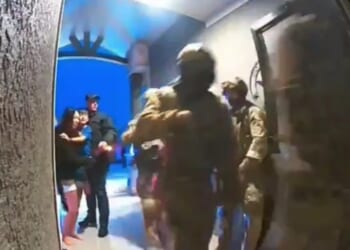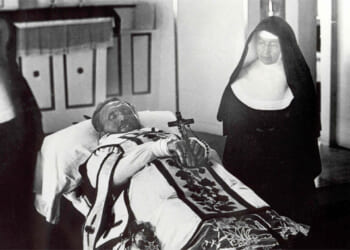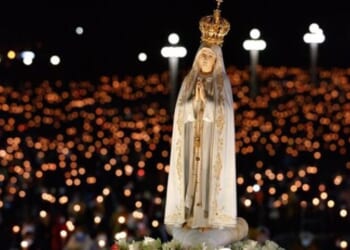At first, his interrogators at the Hanoi Hilton didn’t believe his story; they thought he was a spy!
Wednesday, April 30, 2025, marks the fiftieth anniversary of the end of the Vietnam War. As luck would have it, over the weekend, I had the honor and pleasure of meeting a Vietnam War veteran named Marc Leepson at a private speaking engagement. Leepson is a historian, journalist, and author of eleven books.
The book that Mark discussed at this speaking engagement is titled The Unlikely War Hero: A Vietnam War POW’s Story of Courage and Resilience in the Hanoi Hilton. The war hero in question is Doug Hegdahl, who was the youngest and lowest-ranking prisoner of war (POW) at that infamous North Vietnamese prison camp (official name Hỏa Lò Prison). At the time his ordeal began, Doug was a mere twenty-year-old Seaman Apprentice (pay grade E-2).
Though we at The National Interest won’t be able to do proper justice to Doug’s story nearly to the extent that Marc did in his speech or his book, we’ll still give it the old college try.
Doug Hegdahl’s Early Life
Douglas Brent Hegdahl—“Doug” to all his friends and family—was born on September 3, 1946, in Clark, South Dakota, to Abe Hegdahl and Edythe Serene Herigstad, both second-generation Norwegian-Americans.
Doug played on the football team and wrestled in the heavyweight class at Clark High School. However, he was, as Marc put it, “smart but unmotivated”; in other words, he was highly intelligent but didn’t apply himself, and he took an extra year to graduate from high school (he’d also had to repeat the first and sixth grades). He finally graduated in 1966 at age nineteen-and-a-half, by which time he was just over six feet tall and weighed a hulking 225 pounds.
Doug’s Initial Military Career
Doug received his draft notice for Vietnam the summer after graduation, and, in his own words (as quoted in Leepson’s book):
“I think most everybody in the Midwest always wanted to see the world and get away, so I probably would have joined the Navy even if there hadn’t been a war going on. But I did get my draft notice and passed my physical for the Army and my mother took me to see the Navy recruiter [in Watertown, South Dakota] and you know how mothers are. [She] probably thought it was safe to go into the Navy, so I enlisted.”
During his weekend speech, Leepson added that the Navy recruiter lured Doug into enlistment with the prospect of getting to visit Australia. Ironically, Doug never got to see Australia during his U.S. Navy career but did end up on an American warship named for an Australian city: the guided missile cruiser USS Canberra (CA-70), which was commissioned in 1943 and named in honor of the Australian heavy cruiser HMAS Canberra (D33), which sank after receiving heavy damage during the Battle of Savo Island on August 9, 1942. USS Canberra thus became the first U.S. Navy warship to be named for a foreign capital.
However, before Seaman Hegdahl could be posted on the Canberra, he had to get through Navy boot camp first. His same penchant for goofing off that delayed his high school graduation came back to bite him again, as he had to be “recycled,” i.e., redo basic training.
Doug’s Vietnam POW Experience
On the night of April 6, 1967, the USS Canberra was in the Gulf of Tonkin, conducting a Harassment and Interdiction bombardment of North Vietnamese positions twelve miles away. Roused from his bunk as he was trying to get some shuteye, Seaman Apprentice Hegdahl decided he wanted to see one of the 5-inch gun mounts in action up close and personal.
“And the next thing I remember I was in the water, and I can’t tell you how I fell from my ship. All I know is, I walked up on the deck. It was dark, and they were firing, and the next thing I recall I was in the water.”
Between the dark and the noise of the gunfire, his shipmates neither heard his cries for help nor saw him fall overboard. He spent four hours adrift before being rescued by a civilian North Vietnamese fishing boat. That boat crew actually treated him well, but then they turned him over to the Communist military authorities, who didn’t treat him so well and transported him to the Hanoi Hilton.
At first, his interrogators didn’t believe his story about being a lowly seaman who fell overboard—they thought he was a spy! Eventually, they came to believe him, and this was where his previously noted knack for being a jokester actually paid off. He pretended to be a dumb country bumpkin who could barely read or write; among other things, this act gave him an easy excuse to avoid signing a confession admitting to war crimes, and his captors soon dubbed him “The Incredibly Stupid One.”
Far from stupid, he used his incredible and previously untapped brain power to memorize the names of 254 fellow POWs. Ordered by his senior officers to accept an early release in August 1969, he shocked his debriefers by rattling off all 254 prisoners’ names and providing harrowing details of the horrific tortures inflicted by the Communist captors. These revelations scandalized the North Vietnamese government, which had only admitted to holding a few dozen POWs, and soon helped compel Hanoi to order the improvement of the prison conditions for the remaining captives.
Where Is He Now?
After separating from the Navy, Doug embarked on a long career as a civilian instructor at the Navy’s Survival, Evasion, Resistance, and Escape (SERE) school in San Diego. He still lives in San Diego but is a very private person, only granting Leepson one brief interview back in 2001. However, Doug referred Marc to his former cellmate, Capt. (USN, ret.) Dick Stratton, who proved to be an invaluable resource of information for the book.
God bless and Bravo Zulu!
About the Author: Christian D. Orr
Christian D. Orr was previously a Senior Defense Editor for National Security Journal (NSJ) and 19FortyFive. He is a former Air Force Security Forces officer, Federal law enforcement officer, and private military contractor (with assignments worked in Iraq, the United Arab Emirates, Kosovo, Japan, Germany, and the Pentagon). Chris holds a B.A. in International Relations from the University of Southern California (USC) and an M.A. in Intelligence Studies (concentration in Terrorism Studies) from American Military University (AMU). He has also been published in The Daily Torch, The Journal of Intelligence and Cyber Security, and Simple Flying. Last but not least, he is a Companion of the Order of the Naval Order of the United States (NOUS). If you’d like to pick his brain further, you can ofttimes find him at the Old Virginia Tobacco Company (OVTC) lounge in Manassas, Virginia, partaking of fine stogies and good quality human camaraderie.
Image: Wikimedia Commons.















